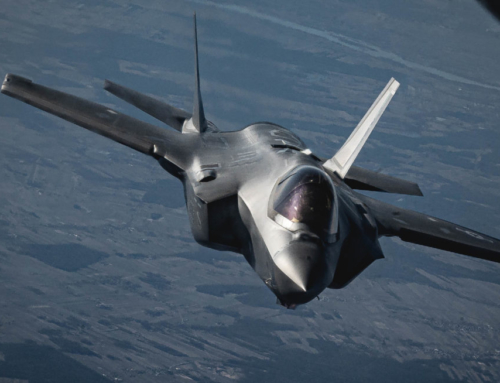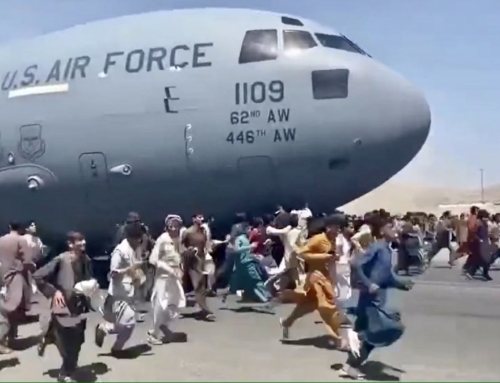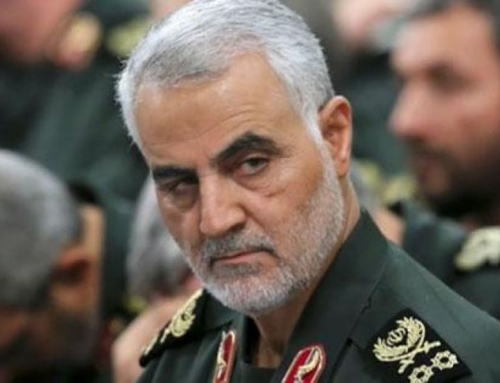The Obama National Security Team announced a dramatic shift in strategy for our military capability yesterday, and after all the bluster about “reorganizing for 21stcentury threats”, I couldn’t help but be struck by how everything said pointed back in time, not forward.
The center-piece of the strategy is cutting down the size of our Army. Making it “leaner and more agile”. No longer will we be structured for “legacy tasks” of stability and support operations or nation-building. Nope, it’s all about “responding quickly and effectively to a variety of contingencies.” Sounds a lot like what I heard during the Clinton drawdowns because of the “Peace Dividend” after the wall fell. We would “pull back from our forward deployed bases” overseas and use “power-projection platforms” (read Army bases) to deploy “Joint Forces” (read Army guys in Airforce aircraft) to any contingency.
While this draw-down has caused a hue and cry about losing our ability to fight two mid-intensity conflicts simultaneously, a corner-stone of U.S. military strategy for as long as I can remember, that’s not what concerns me. In reality, we haven’t had that capability since Reagan was in office.
When I joined the Army in the late ‘80s we had about 780,000 active duty soldiers. By 9/11 we had about 480,000 –along with the mission of being able to fight two mid-intensity conflicts simultaneously. Ten years later, I think it’s been proven we’d lost that ability long before 9/11. We couldn’t even fight two low-intensity conflicts simultaneously, having to use Afghanistan as an economy of force while we focused on Iraq. The Army rose to its current level of about 565,000, and the cuts being discussed will leave it around pre-9/11 size. So, we’ll basically have the Army at the same level we had before the towers fell. We’ve just become honest with what that capability can accomplish.
Along with the force structure, our strategy is returning to the past. And not the distant past, either. The only buzz-word missing from Thursday’s announcement was “information dominance”, a term that was going to ensure we’d win every conflict with little more than a platoon. You couldn’t swing a dead cat without hearing it in the late 90s.
“What’s that, soldier?”
“An M-16 rifle. It allows me to achieve information dominance on my opponent.”
Outside of that absence, every other buzz-word from the past was used. No longer will we need the “legacy force” for large stability operations. No, tomorrow’s war will be quick and sharp, because we’re “agile” and “adaptive”. Really? Sounds remarkably like what Donald Rumsfeld said when we invaded Iraq in 2003. We’d go in “lean and agile”, and the whole thing would be over quickly. When told otherwise by the then-Army Chief of Staff, a man with experience in Bosnia, Rumsfeld fired him for not toeing the party line. It wasn’t until the “Surge” in 2006 – which could rightly be called “The forces we should have had in the first place” – did we put enough combat power on the ground in Iraq.
Listening to the discussion I found it harkening back to a doctrine developed during the 1990s: The Powell Doctrine. In a 1992 Foreign Affairs article, GEN Powell outlined a series of litmus tests for the application of military force, ostensibly gleaned from his experiences in Vietnam. Boiled down, he said don’t get involved in a conflict unless we can win with overwhelming force and have a concrete exit strategy. And that’s exactly what we did in Desert Storm, right down to not continuing on to Baghdad. In GEN Powell’s words, “Would it have been worth the inevitable follow-up: major occupation forces in Iraq for years to come and a very expensive and complex American proconsulship in Baghdad?”
GEN Powell was right in the costs involved, but costs alone shouldn’t dictate our strategy. I don’t know whether Iraq was worth it or not – history will judge that – but I do know that our security doesn’t rest on what we’d like to do. It rests on what we may be called on to do. 9/11 itself is proof of that. Outside of SOCOM, nobody in the Department of Defense was looking at sub-state entities as a national threat. Today is almost like Vietnam and Colin Powell all over again. We slog it out for ten years in two hard-fought insurgencies and decide we don’t like doing that. So we won’t do that. Unfortunately, the enemy has a vote. Saying we won’t do stability operations is ridiculous. We may not like them, but the alternative is worse. Failed nation-states alone would be bad enough, but now, coupled with the terrorist threat that leverages such environments, it makes the strategy self-defeating. I completely understand the abhorrence of stability and support operations. They’re nebulous, messy, and absolutely draining. I’ve never liked them, and have never found any other military man who did, but we don’t get to pick the fight. There won’t always be a big tank battalion to strike.
To that end, the wording of the strategy is at odds with itself. It’s as if we understand the hazards, but don’t really want to face them. In the actual document, the first mission listed is Counter-terrorism and Irregular Warfare, and yet irregular warfare, by definition, is a stability operation. The document goes on to say: Achieving our core goal of disrupting, dismantling, and defeating al-Qa’ida and preventing Afghanistan from ever being a safe haven again will be central to this effort. Huh? How are you going to prevent Afghanistan from being a safe-haven? Cyber-warfare?
Leon Panetta stated we were “obviously facing 21st century threats”, like we should forget about humans and begin planning for Klingon invasions, yet the two largest threats on the horizon, outside of terrorism, are North Korea and Iran – threats that have been around for decades. What’s 21st century about that?
Holistically, the strategy implies that we will counter aggression, but won’t take it to its natural conclusion should that be necessary. We’ll push North Korea back, should they attack, but won’t continue on – because that would entail a follow-on stability operation. The strategy itself states our forces…will be capable of denying the objectives of – or imposing unacceptable costs on – an opportunistic aggressor… Read that closely. It’s basically stating we’ll get them to quit, then call it victory.
In the end, I’m not making a judgment on the strategy. The fact is that we are in a financial crisis, and cannot sustain the defense spending we currently maintain. Along with that, we’re still going to have the force structure we had prior to 9/11, which nobody seemed to think was shallow back then. I’m confident that we can, and will, be able to confront whatever threat presents itself. What concerns me most is what happens after major combat operations are over – or worse the loss of preventing major combat operations because we refuse to conduct stability missions. Are we really going to throw out that option until the blister becomes gangrenous, forcing a “short, sharp” war?
While paying lip-service to Stability and Counter-insurgency operations, what the strategy is really doing is telling the leadership to forget about such missions. In so doing, we risk losing the very lessons learned through ten years of fighting – just like we did after Vietnam. We may never have to do nation building, counter-insurgency, or stability and support operations ever again, and that would be fine with me, but I think it’s myopic to believe it. The world is full of flash-points that may suck us in, regardless of our perceived national interests, such as Bosnia in the 90s. Obama considered sending troops to Darfur, Sudan because of the genocide, and at this very moment, US troops are in Uganda helping combat the Lords Resistance Army. It’s a minimal deployment right now, but what if it expands into the dreaded “Stability Operation”?
When that happens, I don’t want to pay for old lessons with new American blood.










As a Vietnam era marine I have watched the drawdowns with some trepidation. my son was a 20year marine reservist with 4 full overseas tours ( Iraq and Somalia) and honestly wonder how this is going to work. Talk is cutting a whole division from a already grossly undermanned branch of service. Reservists are not supposed to do that many tours and I wonder how the folks in charge think any branch of our armed services can continue to function properly. The idea of small mobile forces certainly has merit but the trend towards totally depending on technology alone to keep us safe at home honestly makes me nervous. Thank God for our troops, both civilian and military. Semper Fi Colonel
[…] Return to Web Site ← New defense strategy: Back to the future. […]
Two Questions:
1) Ever read Thomas PM Barnett/’The Penatgon’s New Map’ and ‘Blueprint for Action’? If so, thoughts?
2) What’re your thoughts on Panetta’s recent publically addressed fear of a cyber attack on the US power grid/net?
Kiekbusch
Twin Cities
Joel, I bought The Pentagon’s New Map when it was first published, but I never had time to read it. I forgot it was on my shelf. I’ll have to track it down. As for a fear of cyber attack on the power grid, I think he’s right on. We are very vulnerable to that sort of thing, but I don’t think it will be catastrophic at this juncture. Our power grid is so distributed and ad-hoc, being built layer-by-layer on top of itself, that it would be hard to get national-level effects purely by cyber. It would be like trying to bring down the internet. The primary problem is this ad-hoc system is getting more and more integrated with “Smart Grid” technology that is more vulnerable. The more we begin to centralize the control processes in an effort at efficiency, the more it becomes susceptible to Pearl Harbor-type scenarios. Right now, you could do some serious damage if you hit the right nodes, which is what Panetta is concerned about, but I don’t lose sleep thinking about it. He was referring to cyber in general, which is a growing and distinct threat not only to our power grid, but to the financial sectors, water, railway, air traffic, you name it.